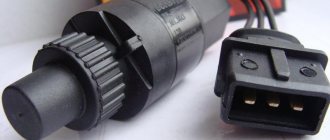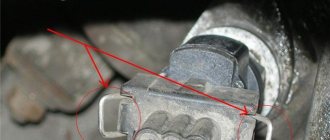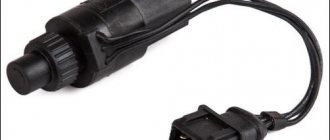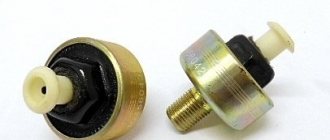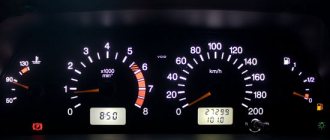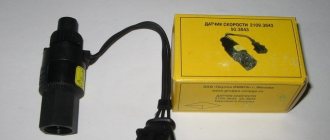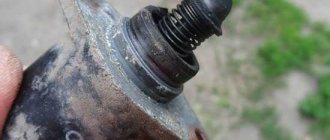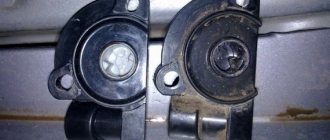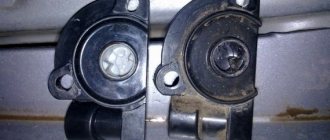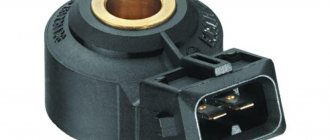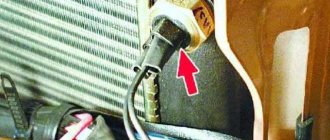Basic principles of system operation
The Hall effect is the principle of reading electromagnetic pulses. There are magnetic marks on the car shaft, the impulse from which is read by the sensor. A certain number of shaft rotations is programmed into the control unit, corresponding to the kilometer traveled, equal to 6004. As the speed increases, the interval between pulses is reduced, the information is processed and displayed on the instrument panel.
The vehicle's on-board network is designed so that all components and assemblies function smoothly, and control is as comfortable as possible. According to international standards, the voltage is 12V to be compatible with most consumers.
The circuit itself is single-wire. In practice, this means that the “negative” terminal is connected to the car body, and each individual device is powered by a “positive” wire. This greatly simplifies the routing of wires along the body and reduces the number of wires required. It also reduces the likelihood of cable damage and, as a result, a short circuit.
Device location.
Each vehicle is equipped with only the appropriate equipment, designed for a certain number of shaft rotations and installed in the appropriate seat. The Chevrolet Niva speed sensor is installed on the gearbox.
The sensor itself is a small steel or, more often than not, plastic device that is mounted in the shaft area. Inside the case there is a core that transmits impulses to a special controller responsible for displaying information on the instrument panel.
When carrying out work, it should be taken into account that the device can be quite fragile, so installation should be carried out with care.
Also interesting: Niva Chevrolet speed sensor - Auto magazine MyDucato
A broken dashboard is the first thing you think about.
The main problem that most drivers think about when there is no speedometer and odometer reading is the breakdown of the dashboard itself. Perhaps some plastic gears in the speedometer, which are so unreliable, have broken, and the connector has come loose from the odometer. There can indeed be a lot of reasons for problems; each reason has its own characteristic manifestation. But often the culprit for the lack of speedometer reading is not the dashboard itself. This element can break for several important reasons:
- a problem that has appeared for a long time, which has not found a normal solution and a sufficiently high-quality diagnosis;
- simultaneously with the cessation of displaying the speed and kilometers traveled, the dashboard backlight also disappeared;
- the wires from old age and difficult operating conditions have become frayed and shorted, creating a local short circuit;
- water got into the instrument panel, the electronic mechanism did not withstand such a test and stopped functioning normally;
- during operation of the car, a certain sound emanates from the instrument panel, similar to a buzzing sound (gears are broken);
- On old mechanical speedometers, the fastening of the cable going to the panel from the gearbox often fails.
Such problems all have a fairly simple solution, but often car owners decide to replace at least the speedometer, or at most the entire dashboard. This is very expensive even for an old domestic car, since the devices have always cost a lot. It is interesting that after going through all the steps of replacing and installing a new speedometer or even a factory-made instrument panel, just removed from the factory packaging, you will not always get the desired results. The expected speedometer operation may not begin for many reasons, including the following:
Door harnesses
There are wires running through the interior that connect to the door wiring. They ensure the operation of power windows, speakers, alarms, heated rear windows, etc. Each line has a socket, thanks to which the door can be easily removed and replaced.
Let's note some features:
- each harness has wires going to the central locking moderator; in more advanced models, the rear doors have wires for the interior lighting and the window regulator;
- the driver's door harness goes to the buttons for the two power windows of yours and the passenger's;
- in the front doors there are wires going to the speakers that are located in them;
- The rear door harness is one of the most complex - it includes wires for the heated glass, wiper and washer gear, rear brake light, central locking and ground wires.
You can see door wiring diagrams in the picture. They all originate from the rear harness, which goes to the taillights.
Niva Chevrolet speedometer does not work
Modern cars have a large number of sensors that correct the operation of the car. And they are all very strongly interconnected. If the Chevrolet Niva speedometer does not work, then there may be several reasons for this, ranging from the speed sensor to the electronic control unit. This, in turn, can lead to improper engine operation, increased fuel consumption and other problems. Therefore, a non-functioning speedometer is not only a problem with traffic control, but also a possible cause of major malfunctions. This means that it is urgent to diagnose the car.
In the Niva Chevrolet, the speedometer needle is driven not by a cable, as on old cars, but by an electronic control system, which is controlled by a magnetic sensor. The speedometer needle is an ammeter driven by the difference in current transmitted by the sensor.
If, as a result of diagnostics, a problem is identified with the instrument panel, then in most cases it may require a complete replacement, since it is non-repairable and its components are located on one board.
The speed sensor transmitting the impulse to the instrument panel is installed on the transfer case. These signals are transmitted to the ECU, where they are processed, engine parameters are read and transmitted to the instrument panel.
It is quite simple to determine problems in the operation of the speedometer: these are inflated indicators, for example, when a car shows clearly inflated speed indicators, the needle twitches during uniform movement or does not rise from the zero mark.
There are several main reasons that can affect the operation of the speedometer:
- Mechanical damage to the instrument panel
- Damage to wiring or contacts
- Short circuit
- Speed sensor failure
- ECU failure
Some problems can be determined by connecting an OBDII sensor to the panel
If problems with the speedometer are accompanied by a Check Engine error, then in this case the problem will be related to the ECU. By checking it with a sensor, you can most likely detect error 0500.
First, you should conduct a self-diagnosis of the instrument panel. To do this you need to follow a few simple steps:
- Turn off the ignition and hold down the button to reset the daily mileage
- Hold the button to turn on the ignition
- Release the button
- If the instrument panel is working properly, then the instrument arrows should rise to the maximum division and return to their original position.
If the speedometer needle does not move or there are malfunctions in their operation, then the problem is in the instrument panel. You should disconnect it and check the condition of the contact blocks. It is possible that during operation due to vibrations, the contacts in the block became disconnected from the common bundle to the instrument panel.
Pin 9 is used to connect the speedometer. In some cases, for example, when repairing an instrument panel, it may be installed skewed, which may subsequently affect the operation of the system.
If these steps do not help, then you need to check the contact block on the speed sensor. To do this, you need to install the car on an inspection hole or overpass. It is located at the bottom of the transfer case and water and reagents used to treat roads can get on it.
After this, you need to check the wires leading from it to the speed sensor. The wire may fray or suffer other mechanical damage. The car body carries a negative charge - mass. And if the wire sheath is damaged, a short circuit may occur.
It is also necessary to pay attention to its condition. It is often made not only in a metal case, but also in a plastic one, which encloses a core with a winding and a rotor
Depending on the rotation speed, the level of current generated and, accordingly, the position of the speedometer needle depend.
This element is not repairable, since it is enclosed in a solid body. Therefore, if malfunctions occur, it must be replaced. You can check its performance using a multimeter. Before doing this, you need to remove it:
- The terminals are disconnected from the sensor
- The sensor is unscrewed
- An inspection and assessment of its condition is carried out.
- There are three terminals suitable for the sensor: minus, plus and central pulse. When checking, the multimeter is connected with a negative probe to ground, and a positive one to the central connector
- A tube is placed on the sensor roller and the multimeter is switched to minimum measurement mode
- Using the tube, the sensor rotates, and if it is working properly, the multimeter should show deviations from the rest state.
If the multimeter does not show the operation of the element being measured, it means that it is faulty and requires replacement.
Connection diagram
The Shnivy sensor connector itself is a three-pin connector, where:
- red – plus;
- black – minus;
- blue – signal.
The electrical diagram of the element will tell you how the wiring is connected to the speedometer.
Skipping the details and complexity of the speedometer drive pinout, you should focus on connecting the sensor itself. There are three wires here.
- Cable number 1 is a plus, goes to the brake fluid sensor. To maintain constant nutrition.
- The second wire is connected to the speedometer and is responsible for transmitting the signal.
- The third one is black. The cable is responsible for the minus and is connected to another similar wire, or screwed onto the car body, directly at the installation site.
Symptoms of DPKV malfunction
Problems with DS arise from time to time, but not all of them require replacement. Some of them are caused by third-party reasons, such as:
- oxidation of contacts,
- wire break,
- damage to wire insulation,
- damage to gearbox mechanisms.
- Difficulty starting the engine “hot” or “cold”;
- When moving downhill, detonation occurs;
- Idle speed is unstable;
- Motor power decreases periodically;
- Acceleration dynamics are passive;
- Sudden engine stop.
However, these symptoms are signs of a number of other breakdowns
It is extremely important to conduct comprehensive diagnostics using digital equipment
| Name / catalog item | Price in rubles |
| VAZ 21214-2123 OMEGA 173882 | From 350 |
| 2112-3847010 | From 350 |
| 21120-384701004 | From 350 |
| 21120-384701036 | From 350 |
Diagnostic connector pins for used protocols
The OBDII standard allows for the use of 5 diagnostic protocols. Chevrolet Niva uses 3 of them:
- J1850 PWM. High-speed protocol with a performance of 41.6 Kb/sec. Transmits signals via pins 2, 4, 5, 10, 16.
- J1850 VPW. (The principle) of transmitting signals via pins 2, 4, 5, 16 is the same, but the speed is 10.4 Mb/s.
- ISO 9141-2. The simplest protocol that does not require complex communication microprocesses (unlike the above). Performs pulse transmission using pins 4, 5, 7, 15, 16
If the system does not have pin 7, the SAE J1850 VPW (Variable Pulse Width Modulation or Pulse Width Modulation) protocol is used. The specified signal transmission protocols function properly via a standard OBD-II J1962 connector cable.
Replacing a car speed sensor
As for its location, look for the DS in the engine compartment in close proximity to the exhaust manifold. To be honest, the place where it is installed cannot be called ideal. While the car is running, the manifold heats up. The sensor wires rub against it, which over time leads to malfunctions and short circuits. Therefore, experts recommend that the first step is to properly insulate the wiring, and also use some kind of clamps so that the wires do not come into contact with the collector. This significantly extends its service life.
It doesn’t matter whether you have an injection car or a carburetor with a Europanel - the connection of the speed sensor to the instrument cluster is identical.
Replacing the VAZ speed sensor: step-by-step instructions:
- Drive into the pit - it will be more convenient to work from below - and wait until the engine cools down.
- Turn off the vehicle's power by removing the cable from the negative terminal of the battery. Do not close the hood after this, this will provide you with lighting.
- Locate the speed sensor on the transmission. Clean it and everything near it with a rag to remove any dirt.
- By pressing the spring clip, disconnect the wire block from the sensor.
- Dismantle the sensor itself by unscrewing it counterclockwise - with your fingers or an open-end wrench to “22”.
- Carefully, so as not to break anything, install a new part in place of the removed part. Connect the wire block to it and the procedure for replacing the speed sensor can be considered complete.
How to properly connect a new DS? It is important here that the device rod fits correctly into the fixing sleeve, otherwise rotation will not be transmitted to the sensor. If the sensor fits into the socket the first time, then everything is in its place, and if something prevents it from moving, then the rod did not fit into the bushing. The most common causes of speed sensor failure
The most common causes of speed sensor failure.
Any breakdown is not the end of the world, but a completely solvable problem. Sensors are classified as measuring instruments; they convert measured physical quantities into electrical signals and display digital data on a display.
The speed sensor is a device that uses the Hall principle, i.e. the phenomenon of the appearance of a transverse potential difference when a conductor with direct current is placed in a magnetic field. The speed sensor outputs rectangular pulses, the period (time interval between pulses) of which is converted into speed and mileage.
The speed sensor is installed in a seat on the gearbox, does not require additional protection, and in case of a malfunction can be replaced entirely.
It is worth noting that the speedometer shows the correct data with the standard configuration of the VAZ car, in particular, with the tire size recommended by the manufacturer.
External manifestations of sensor malfunctions
— Uneven idling, or stalls in idling mode;
— The speedometer does not work well or does not work at all;
— Increased gasoline consumption;
— Engine thrust decreases.
A common malfunction of the speed sensor is wear of the moving part, and, as a result, its slipping in the gearbox seat. This malfunction is most often expressed in low speedometer and odometer readings or periodic stopping of these devices.
Failure of the electronic part of the speed sensor is also possible, as a result of which the speedometer often fails completely.
Diagnostics of the speed sensor should begin by measuring the power (+12 V) on the first contact of the block and the ground on the 3rd contact. The second contact is a signal one. The operation of the sensor can be checked by measuring the signal on the second contact while driving (or hanging the drive wheel) with an oscilloscope or voltmeter. Measurements should be carried out at a speed of at least 5 km/h. The frequency of the signal when using a voltmeter is measured indirectly, recording the increase in voltage as the engine speed increases. If, when there is power, there is no output signal, the speed sensor output is faulty.
DON'T STROKE - BUY CHEAPER! ! !
If you haven't found the answer you are looking for, then ask your question! We will respond shortly.
Don’t forget to share the information you find with your friends and acquaintances, as they may also need it - just click one of the social networking buttons.
Diagnostics
Troubleshooting begins by disconnecting the wiring block from the speed sensor harness and checking them using a test light.
To make a control light bulb, you need any car lamp that can operate at a voltage of 12 V, and two wires about 1 meter long each. One of the wires is attached to the positive terminal, the second - to the negative terminal of the lamp. The resulting device also includes a Krona battery.
To carry out the test, one wire of the warning lamp is attached to the ground of the body or battery, and the second is made with short, frequent touches to the middle contact of the DC connector.
If there are no faults in the connector-speedometer section, the speedometer needle will slightly tremble or rise.
If the needle shakes, the answer to the question why the speedometer does not work can be considered found - the speed sensor requires replacement.
In cases where the needle’s response to tapping on the central contact of the block cannot be detected, it is necessary to “test” the speedometer power circuit. The procedure is carried out using a multimeter (multitester), or by using the same light bulb - a control.
If the tester in the “continuity” mode indicates a violation of the integrity of the circuit, further troubleshooting is carried out in this direction. It is necessary to check the fuses, the connection points of the wires, and their integrity inside the insulating braid.
Speedometer adjustment in Moscow - https://probeg-moskva.ru/glavnaya/avtomobili.html
The search area can be reduced by gradually “ringing” individual sections of the circuit. On model 2114 and other VAZ products, the cause of speedometer failure is often oxidation of the “mass” contacts attached to the car body.
In cases where the speedometer needle does not work, but there is no evidence of malfunctions in the electrical supply circuit, a logical conclusion is drawn about the malfunction of the device itself. Additional testing can be done by temporarily installing a known good instrument panel.
About the sensor
The speed sensor in a Niva car is designed not only to indicate the speed of the car, but also for other actions that you most likely had no idea about.
DSA is involved in the formation of the fuel mixture necessary to maintain higher speeds when driving a car with neutral gear engaged. If you are coasting your car, you can replace that the idle speed is slightly higher than when the car is stationary.
Another function is to provide vehicle speed readings to the electric power steering. As the speed of the car increases, the force of rotation of the steering wheel increases, this is necessary for clearer and more accurate maneuvering of the car.
In older versions of cars, the DSA was replaced with a cable; with the arrival of the new Niva 21213, this process became electronic. Below, the article describes in detail the signs of a sensor malfunction, its price, testing methods and replacement.
OBD 1 pinout
To correct the operation of electronic systems, OBD equipment was invented. The first generation pinout has a rectangular shape with 12 pins.
Each of the elements of the nest has its own purpose:
- pin A transmits mass information;
- B corresponds to the diagnostic L-line;
- D—CO potentiometer;
- contact G is responsible for the fuel pump control functions;
- H—food;
- M - K-Line diagnostics.
At the bottom of the pinout there is a “Key”, which is responsible for maintaining the correct design of the equipment. This element is designed to ensure the correct orientation of the plug and connector in the car.
Car brands and years of manufacture
Any injection model before 2002 has an OBD1 pinout. When determining the type of diagnostic connector for 2002 cars, it is worth considering that some may already use OBD2. They can be easily distinguished by their “rosette” shape.
Access and location
To find OBD1, just look behind the steering column - where the ignition switch is located. The connector is accessible to the driver.
Operation of the electromechanical speedometer
Devices with a similar operating principle are more popular, especially in the domestic automotive industry. Their configurations are different. The essence of the work remains unchanged and is similar to mechanical analogs; there is a speed sensor and the counting unit itself. The only difference is the implementation of the functions.
The following sensors are used in electromechanical devices:
- conventional gears connected to the secondary shaft of the efficiency and drive the left wheel;
- pulse, operating on the basis of the Hall effect;
- induction;
- combined.
High-speed units can be modified, magnetic induction units with indication of magnetoelectric devices. They work in conjunction with a gear vehicle speed sensor. Counting units with an electronic unit base and an indication provided using a milliammeter are considered accurate. They operate in conjunction with combined and electronic sensors.
In modified systems, measurement is provided using a special microcircuit or sensor that sets a signal and converts it by an electronic unit, transmitting readings to devices. The magnitude of the current is proportional to the speed of the car, and the arrow of the device is in this dependence. In high-speed nodes, the block processes the signal received by the speed sensor. The principle of indication remains the same.
Characteristic symptoms of the problem
Practice shows that a malfunction of the camshaft position sensor does not lead to engine failure and immobilization of the vehicle. The engine continues to operate with some deviations that interfere with the normal operation of the car. Symptoms of DPRV failure are quite vague and similar to problems with other measuring elements:
- Unstable engine operation at idle and while driving.
- Instead of dynamic acceleration, after pressing the gas pedal, there is a series of small jerks and a sluggish increase in speed.
- The power of the power unit decreases. The effect becomes noticeable when the load increases - on a hill, sharp acceleration, while towing a trailer.
- The Check Engine light on the dashboard does not always come on. But many drivers note that if the meter is faulty, the display flashes after the crankshaft speed increases to 3000 rpm or more.
- Fuel consumption is naturally increasing.
If the measuring element is faulty, the control unit prepares and supplies an enriched air-fuel mixture to the cylinders. This results in an increase in gasoline consumption and unstable idling. Jerks and drops in power are caused by untimely supply of a spark - the controller “does not see” the end of the compression stroke in the cylinder and cannot clearly determine the ignition timing.
On various car models, additional symptoms of a malfunctioning camshaft sensor are noted:
- the engine suddenly stalls while driving, but starts without problems;
- cold starting of the engine becomes difficult;
- on cars equipped with a robotic gearbox, difficulties arise with automatic gear shifting;
- the engine “troits” - skipping ignition cycles is heard, sometimes popping sounds are observed in the exhaust manifold;
- On some cars, the power plant fails due to lack of sparking.
Driving with a broken air pressure sensor is acceptable for a short period. Jerking, rich fuel mixture and electronic errors accelerate the wear of spark plugs and engine parts. After detecting the listed symptoms, you should send the car for diagnostics or find the source of the problem yourself.
Meter design and location
The operating principle of the DPRV is based on the Hall effect - the sensor reacts to the approach of a metal mass by changing the voltage on the signal wire. The design of the device is similar to another element - the crankshaft position detector. Inside the plastic case there is a coil where the 12 V on-board voltage is constantly supplied.
The meter is installed on the engine cylinder head in close proximity to the camshaft. The latter is equipped with a special plate or gear, whose rotation affects the DPRV. The work algorithm looks like this:
- After turning on the ignition and starting the engine, a supply voltage of 12 V is supplied to the sensor. Through the third signal wire, the element supplies the controller with a voltage of 90–95% of the original one.
- When the protrusion on the rotating part of the camshaft passes next to the DPRV housing, the voltage at the signal contact drops to 0.2–0.4 volts, depending on the design of the device and the vehicle model.
- When the voltage drops, the electronic unit clearly “sees” the valve timing, promptly supplies the fuel mixture to the engine cylinders and directs the spark discharge to the desired spark plug.
Replacing a faulty Chevrolet Niva speed sensor.
The sensor is located on the rear cover of the transfer case. Before removing it, you must disconnect the terminals. They are held in place by a plastic retainer.
Also interesting: Connecting PTF via relay and button
Then, using a wrench, the device is unscrewed from the seat.
Before installing a new device, you should carefully examine its condition. On the sensor, the assembly points and contact group must be carefully filled with varnish to prevent the penetration of water. Otherwise, the device may soon fail.
The ECU uses information from the mass air flow sensor to determine the duration of the injector opening pulse.
To remove the DS, you need to place the car on a level surface. After this, it is best to disconnect the battery terminals to avoid errors in the BC.
Disconnect the wire terminals; to do this, press the plastic lock on the block. After this, use a wrench to unscrew the sensor from its seat. If you cannot unscrew it immediately, it is not recommended to use excessive force. You need to treat the threaded connection with WD-40, wait a few minutes and continue dismantling.
Installation of a new DS is carried out in the reverse order. When purchasing a new part, you need to pay attention to the external condition: the contacts must be treated with a sufficient amount of varnish, as this protects them from moisture. After completing the work, it is necessary to reset the on-board computer errors in order to remove the CHECK ENGINE error.
Read news about the new Niva
- Chevrolet Niva camshaft sensor
- Where is the Niva Chevrolet knock sensor located, its installation and malfunctions
- Clutch pedal position sensor VAZ
- Instrument panel Niva Chevrolet designations. Improving the Chevrolet Niva dashboard
- VAZ engine detonation, causes of detonation of injection and carburetor engines
- Niva Chevrolet speed sensor - Auto magazine MyDucato
- Chevrolet Niva camshaft sensor
- Review of the standard alarm system Niva Chevrolet
Speed sensor Niva 21214. Purpose, repair and replacement
On modern cars it is almost impossible to find a mechanical drive for measuring speed. Including the Niva 21213, a cable-free speed sensor (DS) is currently installed.
This is an electronic device that reads engine operating parameters, based on which the on-board computer calculates the speed of the car. Let's consider the principle of operation of this sensor and possible malfunctions that arise during its operation.
A speedometer is installed on the Niva's instrument panel, which is necessary to display the current speed of the car. In the event of a malfunction, driving becomes difficult as most roads have speed limits that must be followed. In addition, a malfunction of the speedometer can affect the calculation of other data by the on-board computer. Based on the DS data, the required fuel consumption is determined and gasoline savings are ensured while idling.
The speed of a car has long been measured not mechanically, but electronically. This measurement is based on the principle of the Hall effect, using a special device. The Chevrolet Niva is equipped with the same electronic device, which accurately reads the speed developed by the car.
Each car has a speedometer in its design, which displays the speed of movement of the vehicle. But the speedometer is only a display of useful information; the main function of indicating the speed of movement is performed by the sensor. If it malfunctions, further travel becomes a pain, especially on city highways, where it is necessary to maintain the speed of movement.
Therefore, the main function of the device is to read information about the movement of the vehicle. Indirect functions of the device include:
- possibility of rational fuel consumption;
- regulation of traffic according to road markings and signs;
- makes it possible to regulate speed in order to avoid fines.
It is possible to drive a car without this part, but it is quite difficult.
There are two types of speed sensors:
- Mechanical or optoelectronic. It works by transmitting the number of revolutions of the box shaft using a cable.
- Electronic or cableless. Actually, that’s what we’ll be talking about.
OBD 2 pinout
The 12-pin OBD1 in the Chevrolet Niva has been replaced by OBD2. This is due to the introduction of new standards in Europe since 2001. This solution has significantly expanded the possibilities of car diagnostics.
The first copies of the equipment showed general error information. Using OBD2, the car owner can independently obtain complete information on the state of the ECU by using a scanning device or adapter. 16-pin connector. Its shape has changed: now it is a trapezoid with a narrowing downwards.
The plug contacts are responsible for the following diagnostic elements:
- pin 2 - bus+ (via J1850);
- 4 — body grounding;
- 5 - signal grounding;
- 6 - CAN-High line (via J-2284 protocol);
- 7 - K-Line;
- 10 — bus- (via J1850);
- 14 - CAN-Low line (via J-2284 protocol);
- 15 — L-line;
- 16 - battery powered.
Car brands and years of manufacture
OBDII has been used in cars since 1996 in the USA. In Europe, standards changed in 2001. In the Chevrolet Niva, new diagnostic connectors first appeared in the 2002-2019 models. These cars work with control systems BOSCH MP7.0 Euro-3, BOSCH M7.9.7, January-7.2, January-7.3.
Signs of breakdown
The car itself can tell you that the DS is out of order. To do this, you just need to pay attention to the characteristic signs of such a breakdown:
- The speedometer does not work at all or provides incorrect information about the current speed;
- Idling behavior is unstable;
- Gasoline consumption is increasing;
- The motor does not produce full power.
The practice of VAZ 2109 owners shows that the most obvious sign of a breakdown of the engine is the engine stopping at idle while coasting, or the engine stopping when the clutch is pressed to change speed.
If the engine breaks down, the “Check Engine” light on the dashboard should light up. If the car is equipped with an on-board computer, then the error code corresponding to the malfunction is 24.
Causes of failure
There are several main reasons why a DS may stop working:
- There is a break in the electrical circuit. Therefore, first of all, we advise you to check the condition of the wiring and contacts. They could become dirty or oxidized. It's not difficult to clean them. Additionally, we recommend treating contacts with Litol.
- Break near the connector. Here the wiring often bends and chafing occurs. Don't forget to check the condition of the insulation of the wires that are located near the exhaust manifold. Often they melt under the influence of temperature, which leads to short circuits.
- The speedometer cable is worn out. Over time, as the vehicle is used, the cable becomes covered with burrs, cracks, and breaks. As a result, the speed sensor stops working properly.
Verification methods
The first thing you need to do is make sure that a voltage of 12 V is supplied to the DS contacts. Since the operation of the DS is based on the Hall effect, the test is performed by torsion. The voltage varies within 0.5-10V.
Today, there are three main ways to check the performance of a speed sensor. The first two involve the use of a multimeter. Which one to choose, decide for yourself. We will talk in detail about all three methods of checking DS.
| Verification method | Your actions |
| Method one |
|
| Method two |
|
| Method three |
|
If checking the DS shows that everything is fine with it, be sure to check the functionality of the sensor drive. It is necessary to hang up the front wheel and find the DS drive by touch. Now start rotating the wheel with your foot and check with your hand whether there is rotation in the drive and how stable it is. The help of a partner will not hurt you here.
Description of DS
As we have already said, the main purpose of the speedometer drive sensor is to accurately determine the speed of the vehicle. Thanks to this device, the model can always know at what speed his car is moving. As for the varieties, DS can be of the contact or non-contact type. Today, most of our compatriots prefer contactless options. Contact DS, despite all the advantages, have one significant drawback - they are prone to contamination, which in turn will lead to inaccuracy of the displayed readings.
Design and principle of operation
Structurally, according to the diagram, this part consists of:
- speedometer drive;
- housings;
- as well as the controller itself with a connector for connecting to the on-board network.
As for the principle of operation, it is based on measuring the frequency level of signals from the controller, which is located on the gearbox housing or transfer case. At the output of the device, while driving, rectangular pulses are formed, the minimum value of which should be at least 1 volt, and the maximum value should be at least 5 volts.
According to international standards, the controller must generate about 6 thousand such pulses over one kilometer. The pulses themselves are subsequently converted into current, which is measured by a magnetoelectric device. It should be noted that the current value directly depends on the number of signals supplied per certain unit of time. That is, this value will be directly proportional to the speed of the vehicle.
In addition, thanks to the electronic circuit installed in the dashboard, the operation of the stepper motor is ensured by counting incoming signals. The latter is designed to rotate the counter reels, after which it displays the relevant information on a small screen, where the total and daily mileage of the car is shown. If we are talking about daily mileage, then this value can be reset to zero if necessary.
Symptoms of a problem
If the DS for some reason fails, this will lead to the control unit being unable to determine the speed of movement. However, this is not the only problem, since malfunctions in the performance of the power unit may also occur.
We suggest that you familiarize yourself in more detail with the signs of a malfunction, by which you can determine the failure of the DS:
- the speedometer on the dashboard has either stopped working altogether or displays incorrect readings;
- malfunctions appear in engine operation, in particular at idle speed;
- fuel consumption increased;
- engine performance has deteriorated, the power unit cannot reach the required speed;
- the engine may stop spontaneously while idling, in particular when the driver tries to press the clutch to change gear;
- if the car is equipped with an on-board computer, a Check indicator may appear on the dashboard;
- if the car is equipped with an electric power steering, this unit may also fail;
- in some cars, for example, Lada Kalina, failure of the diesel engine can also lead to increased sensitivity of the fuel level controller in the gas tank (the author of the video is the Autoelectrics HF channel).
As for the reasons, as a rule, they are caused by damage to the car's electrical wiring, so checking the functionality should begin with diagnosing the condition of the contacts and electrical circuits. Perhaps the problem lies in oxidized or dirty contacts, so they will need to be cleaned and treated with a lubricant, for example, Lithol. A broken wiring should be looked for first of all near the connection connector, since in this place the wires are bent and usually frayed.
Also, the cause of the malfunction may be a violation of the integrity of the wiring insulation in the area where the exhaust manifold is installed. At elevated temperatures, the insulation may melt, causing the device to short out. Also, the DS may transmit incorrect readings due to a worn speedometer cable. Over time, cracks and tears form on it, which contributes to the failure of the controller.
